North Sound Baykeeper tours Hangman Creek, Washington’s most polluted stream
By: North Sound Baykeeper
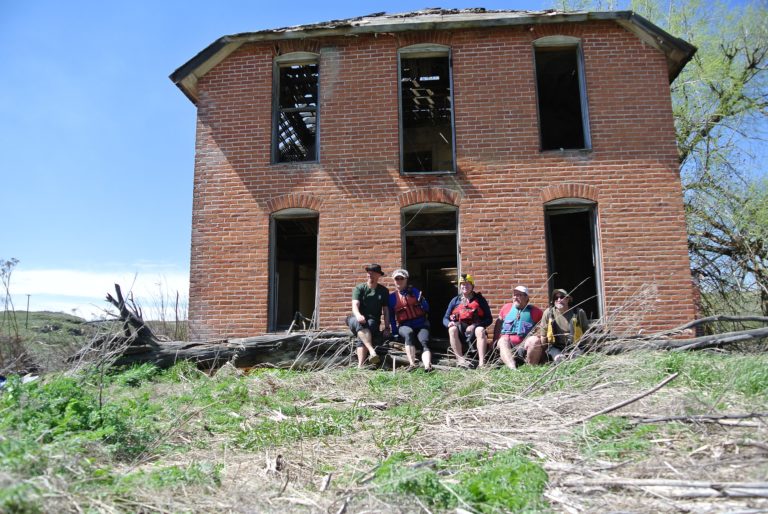
By North Sound Baykeeper Lee First
Reposted with permission from RE Sources for Sustainable Communities
My favorite aspect of being the North Sound Baykeeper is connecting with the Waterkeeper Alliance community, which includes over 315 Waterkeepers around the world. Networking with these water protectors, as well as participating in the Waterkeeper Alliance annual conference, has increased my knowledge and helped me learn how to advocate for water quality in North Puget Sound.
Recently I joined Jerry White and Jule Schultz with Spokane Riverkeeper to take a tour of Hangman Creek and learn more about the watershed they work to protect.
Hangman Creek is a major tributary of the Spokane River and the most polluted creek in Washington state. The pollution is caused by nutrients, warm temperature, sediment, and low dissolved oxygen. Native redband trout and salmon can’t survive this mix — but they used to. The most serious aspect of this pollution is that ongoing discharges from Hangman Creek pollute the Spokane River, where huge sediment loads destroy habitat for trout and other aquatic species downstream.
A chance to paddle the most polluted stream in the state on a multi-day canoe trip winding through Palouse wheat fields? I couldn’t say no.
Beaver restoration at the headwaters
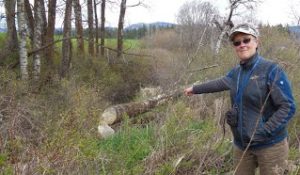 Our first stop was a tour of a beaver restoration site at the Hangman Creek headwaters on the Coeur D’Alene Reservation near Tensed, Idaho. Until a few years ago, this area was a patchwork of winter wheat farms. All the fields were tilled and drained, erosion was commonplace, and the creek was straightened to accelerate drainage.
Our first stop was a tour of a beaver restoration site at the Hangman Creek headwaters on the Coeur D’Alene Reservation near Tensed, Idaho. Until a few years ago, this area was a patchwork of winter wheat farms. All the fields were tilled and drained, erosion was commonplace, and the creek was straightened to accelerate drainage.
Our guide, Gerry Green, is a senior wildlife biologist with the Coeur D’Alene Tribe. Gerry guided us as we walked several miles upstream through an enormous restoration site where the tribe blocked portions of the straightened channel to encourage the stream to meander and access its floodplain. Small wetlands were present near the creek, where tiny tributaries were planted with native shrubs and trees.
As we walked through low stands of sprouting winter wheat, Gerry explained that since the tribe purchased the fields, they were no longer tilled. Instead, no-till methods protected the soil structure and increase the soil’s water holding capacity. Along with no-till, the tribe removed the previously installed drain tiles. The fields now act like a water bank, slowly releasing water to the creek and stabilizing creek flows. Learn more about tile drainage farming.
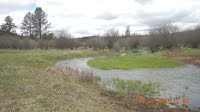 Trees, shrubs, and grass shade the tiny tributaries that flowed down from the hills. Beavers have arrived — as evidenced by small dams and recently fallen trees. This winning combination has already helped hold water back, restoring even flows and cold water for native redband trout.
Trees, shrubs, and grass shade the tiny tributaries that flowed down from the hills. Beavers have arrived — as evidenced by small dams and recently fallen trees. This winning combination has already helped hold water back, restoring even flows and cold water for native redband trout.
Anyone who likes beavers is an instant friend of mine. By building dams and holding back water, the wetlands and ecosystem functions created by beavers support plants, birds, amphibians, mammals, and native fish.
“Water plus aspen plus beavers equal trout,” said Gerry. “Beavers are key. Trout cannot survive downstream because of the sediment load and because of the high water temperatures.” With a system of beaver dams in the landscape, enough water will be held back for base flow to increase and stream temperatures to decrease, enabling native trout to re-inhabit the watershed.
Launching the boats
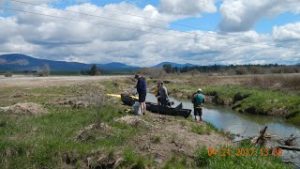 Later that morning, we launched our canoes and kayak downstream from Tensed, Idaho. Here, the creek is small, and the landscape is brutally altered. Huge wheat fields border both sides of the creek, and in most areas, tilled fields extend to the water’s edge and bare sections of soil tumble into the water.
Later that morning, we launched our canoes and kayak downstream from Tensed, Idaho. Here, the creek is small, and the landscape is brutally altered. Huge wheat fields border both sides of the creek, and in most areas, tilled fields extend to the water’s edge and bare sections of soil tumble into the water.
During the first few miles of the trip, we noticed long sections of the creek that had been straightened. These changes, which happened over the last 100 years, were intended to move water off the landscape for more efficient crop production.
We learned the trout downstream of this section disappeared soon after, as water flow increased during high water and caused entrenchment. The fish couldn’t tolerate the sediment-laden water or that the stream dried up in the summer. Trout have not survived in the mainstem of Hangman Creek since 1958, and now only remain in the tiny headwaters of four streams: Mission, Sheep, Nehchen, and Indian Creeks.
Salmon were once plentiful in Hangman Creek, but in recent times, almost no non-tribal residents living in the watershed are aware salmon were once part of the landscape. The Coeur d’Alene Tribe has big hopes that this work enables a productive redband trout fishery, and after that, that the steelhead and salmon will return.
Impacts of drainage
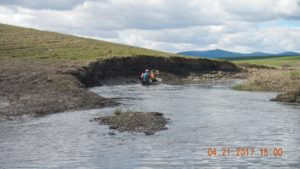 Not long after launching, we observed steep, incised creek banks in some areas, where 10 or more vertical feet of soil was exposed. This isn’t just any soil: it’s Palouse soil. It’s deep and fertile, capable of holding moisture, and it grows the best winter wheat in the United States. It is tilled in huge fields with gigantic tractors, and the miles of drainage tiles funnel a lot of water directly to the stream.
Not long after launching, we observed steep, incised creek banks in some areas, where 10 or more vertical feet of soil was exposed. This isn’t just any soil: it’s Palouse soil. It’s deep and fertile, capable of holding moisture, and it grows the best winter wheat in the United States. It is tilled in huge fields with gigantic tractors, and the miles of drainage tiles funnel a lot of water directly to the stream.
This drainage system increases water velocity and stream instability. Stream flows fluctuate wildly and are unnaturally high during large rain events. Valuable soil is carried downstream, where it clogs fish gills and prevents respiration, smothers fish eggs, and covers gravels the fish need for spawning. Sediment is the most widespread pollutant in the United States.
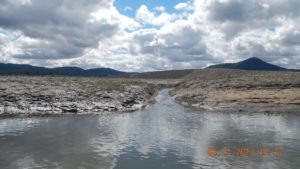 The landscape is captivating: rolling wheat fields, deep incised ditches, abandoned farm buildings, wheat silos, and an occasional bridge. Small crop duster airplanes fly overhead. The smell of chemicals is evident. We paddled through towns and past wastewater treatment facilities and discharge pipes. We saw the stubby ends of hundreds of drain pipes ending at creek banks. The effects of the drainage tile system were everywhere, and it was sobering.
The landscape is captivating: rolling wheat fields, deep incised ditches, abandoned farm buildings, wheat silos, and an occasional bridge. Small crop duster airplanes fly overhead. The smell of chemicals is evident. We paddled through towns and past wastewater treatment facilities and discharge pipes. We saw the stubby ends of hundreds of drain pipes ending at creek banks. The effects of the drainage tile system were everywhere, and it was sobering.
A few areas had healthy buffers and were stunningly beautiful: we saw western painted turtles, native freshwater mussels, owls, and lots of ducks and songbirds. But we also saw tractors with 100-foot-long herbicide spray arms, empty herbicide barrels, old dumpsites, crop duster airplanes, abandoned railroad grades, and an old railroad station.
Lessons learned
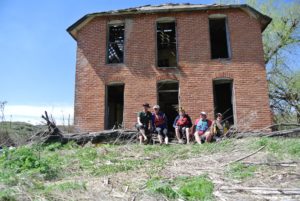 While the differences between the Palouse and Western Washington are many, some lessons learned from Hangman Creek apply here. Similar to the Palouse, our lowland streams are primarily polluted with non-point source pollution from agriculture.
While the differences between the Palouse and Western Washington are many, some lessons learned from Hangman Creek apply here. Similar to the Palouse, our lowland streams are primarily polluted with non-point source pollution from agriculture.
According to the Environmental Protection Agency’s (EPA) National Water Quality Assessment, agricultural non-point source pollution is the leading source of water quality impacts on rivers and streams, the third largest source for lakes, the second largest source for wetlands, and a major contributor to contamination of estuaries and ground water.
As part of my job as the North Sound Baykeeper, I patrol many lowland streams in North Puget Sound. I’ve seen many areas near waterways where critical wetlands and streams are not adequately protected. Similar to Hangman Creek, many farm fields next to streams have miles of drain tiles. With decreased access to floodplains and wetlands, our streams also suffer from flash floods and low water levels in the summer.
Miles of our streams are not shaded, have inadequate or no buffers, are colonized with non-native invasive vegetation, have been straightened, and have no contiguous floodplains.
While Whatcom County’s critical areas ordinance (CAO) requires that in order to use critical areas for farming, the landowner must operate under an approved farm plan. Many farms do have farm plans, but we need to make sure those farm plans are followed and enforced.
If our pollution problems are going to be solved, ALL citizens — whether living in cities or in rural areas — must start caring for our waterways.
More information: If you’re interested in following restoration projects in Hangman Creek, sign up to receive q’e’yminn he ‘ulhnsikwe’n, the watershed newsletter of the Coeur d’Alene tribe.